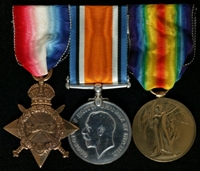

(L to R) 1914-15 Star; British War Medal; Allied Victory Medal
George was born between October and December 1893 in Swindon, Wiltshire. He was named after his father and his mother was Maria Ann. He was their eldest child, and had 3 younger siblings; Elsie Elizabeth, Wilfred and Frederick John.
In 1901 George senior worked as an iron driller at a steel works and the family lived at 22 Malpas Street in Gorton, Manchester. They had moved to Manchester between Elsie's birth in May 1896 and Wilfred's in early 1899.
Ten years later the family, except Elsie, lived at 32 Bull Terrace in Patricroft, on the other side of Manchester. Elsie was living at 187 Liverpool Road in Patricroft, where she worked as a domestic servant for the Newton family.
George senior still worked as an iron driller. George Henry also worked at a steel works; he was a crane driver. We don't know whether this was the same place as his father.
In late 1912 or early 1913 George joined the 5th Battalion of the Manchester Regiment. This was a unit of the Territorial Force. It was headquartered in Wigan, but F Company, one of 8, was based in Patricroft. He was given the service number 1417.
Territorials lived as civilians during peacetime. They trained in the evenings and at weekends, and also went on an annual training camp lasting around 2 weeks.
The First World War broke out in August 1914 and the 5th Battalion was called into service. It was sent to Egypt in early September and arrived there on the 25th. After training they landed in Gallipoli on the 6th May 1915. We don't know when George first went overseas, but he was definitely with the battalion when they went to war in Gallipoli.
Once they had arrived the renamed 1/5th Battalion were quickly sent to the front line trenches. They worked hard to improve their positions, but the British only held a small area and were often under fire from Turkish artillery and snipers.
On the 4th June the battalion took part in the British attack on the village of Krithia. This had been intended to be captured during late April when the first Allied troops landed, but the Turks had been able to hold them off. George and the 1/5th Battalion advanced further than most British units, but this meant when the Turks counter attacked they were cut off and forced to withdraw.
The battalion took its turn in the front lines and in the rear during July, and received reinforcements. Their next major operation began on the 7th August, again near Krithia.
This attack was intended to divert Turkish troops away from the British landings at Suvla Bay. The British advanced and captured Turkish positions, but were forced back by a counterattack. The Turks continued to attack for the next 2 days, inflicting many casualties on the British.
George was killed in action during this fighting. He died on the 7th, aged 21. His body was never found, so he is now one of the 20885 men commemorated on the Helles Memorial in Turkey. George's name can be found between Panel 158 and 170.
At some point after the war George's parents returned to Swindon. His medals were donated to the Museum of the Manchester Regiment in May 1996.




